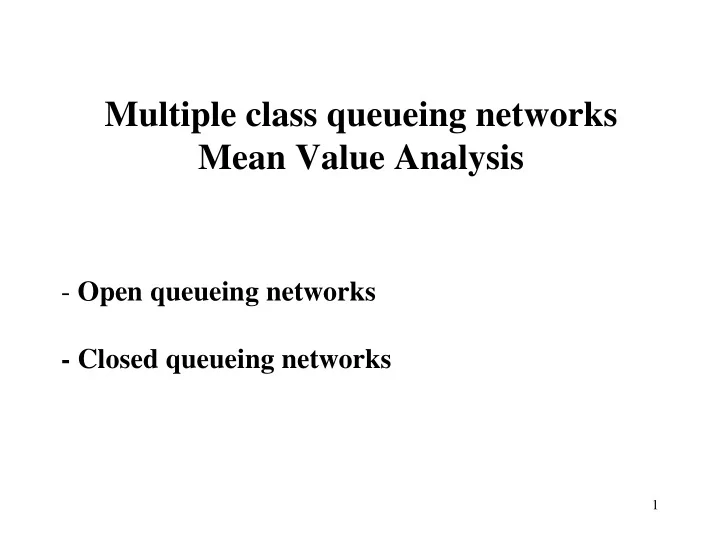

Multiple class queueing networks Mean Value Analysis - Open queueing networks - Closed queueing networks 1
Open queueing network outgoing requests incoming requests DISK CPU CD Closed queueing network (finite number of users) DISK M clients CPU CD 2
Incoming request class Different kind of requests should be in a system (queueing network) that need different services by the servers, i.e: - a database server is subject to two type of transactions: - simple query (that needs only read activities on the disks) - updating transactions (that needs read and write activities on the disks) - a web server is subject to two type of requests: - Read of a little file - Uploading of a big file 3
Definitions K : number of queues i : queue identification r : class identification (from 1 to R) l r : arrival rate for class r request l = ( l 1 , l 2 , ..., l R ) V i,r : average number of visits a class r request makes to server i from its generation to its completion (request goes out from the system if open network) 4
Definitions S i,r : average class r request service time at the server i W i,r : average class r request waiting time in the queue i R i,r : average class r request response time in the queue i R i,r = S i,r + W i,r
Definitions R ’ i,r : average class r request residence time in the queue i from its creation to its service completion time (request goes out from the system in case of open network) R ’ i,r = V i,r R i,r D i,r : request class r service demand to a server in a queue i from its creation to its service completion time (request goes out from the system in case of open network) D i,r = V i,r S i,r 6
Formulas for multiple class open QNs Input parameters D i,r , l r Equations . U i,r ( l ) = l r V i,r S i,r = l r D i,r = R r=1 U i,r ( l ) . total utilization factor i,r ( l ) = D i,r . R ’ delaying resource i,r ( l ) = D i,r / ( 1- R ’ ) queuing resource
Formulas for multiple class open QNs . R 0,r ( l ) = K i,r ( l ) i=1 R ’ . n i,r ( l ) = U i,r ( l ) / (1- ) NOTE: total utilization in the denominator . n i ( l ) = R r=1 n i,r ( l )
DB Server (example 9.5 ) DISK2 CPU DISK1 Class 1 trx: query l 1 = 5 requests per second (tps) D CPU = 0,1 sec Service demand at CPU D DISK1 = 0.08 Service demand at disk 1 D DISK2 = 0.07 Service demand at disk 2 Class 1 trx: updating trx l 1 = 2 requests per second (tps) D CPU = 0,15 sec Service demand at CPU D DISK1 = 0.20 Service demand at disk 1 D DISK2 = 0.10 Service demand at disk 2 9
DB Server (example ) DISK2 CPU DISK1 Query Updates Service demand x • CPU 0,1 0,15 • DISK1 0,08 0,20 • DISK2 0,07 0,10 10
Utilizations (%) CPU 50 30 Disk1 40 40 Disk 2 35 20 Residence times (sec) CPU 0,50 0.75 Disk1 0,40 1,00 Disk 2 0,016 0,22 Response times (sec) 1,06 1,97 11
Multiclass closed queue networks (finite number of users) DISK M clients CPU TAPE 12
Notations N r : fixed number of requests in the system for each class (r) N : (N 1 , N 2 , . . ., N R ) 1 r : vector where all components are zero except for the r-th component, which is equal to 1
Formulas -> Residence Time Equation for class r R ’ i,r ( N )= D i,r [ 1+n i ( N – 1 r )] -> Throughput equation for class r X 0,r = N r / K r=1 R ’ i,r ( N ) -> Queue lenght equation for class r n i,r (N) = X 0,r (N) R ’ i,r -> Queue equation n i ( N )= R r=1 n i,r ( N )
Example with 2 classes Residence Time Equation for class r R ’ i,r ( N )= D i,r [ 1+n i ( N – 1 r )] for example, to evaluate the formulas, when the state is N=(3,4), i.e. 3 customers of class 1 and 4 customers of class 2, we need to know: • the average number of users in queue i when there are 2 customers of class 1 and 4 customer of class 2 • the average number of users in queue i when there are 3 customers of class 1 and 4 customer of class 3 R ’ i,1 ( 3,4 )= D i,r [ 1+n i ( 2,4 )] R ’ i,2 ( 3,4 )= D i,r [ 1+n i ( 3,3 )]
A markov process with 2 classes and 2 users x class 2/Z 1 1/Z 1 1,0 2,0 0,0 X 0,1 (1,0) X 0,1 (2,0) X 0,2 (2,1) 2/Z 2 2/Z 1 1/Z 1 1,1 2,1 0,1 X 0,1 (1,1) X 0,1 (2,1) 1/Z 2 X 0,2 (2,2) 2/Z 1 1/Z 1 1,2 2,2 0,2 X 0,1 (1,2) X 0,1 (2,2) 16
Recommend
More recommend